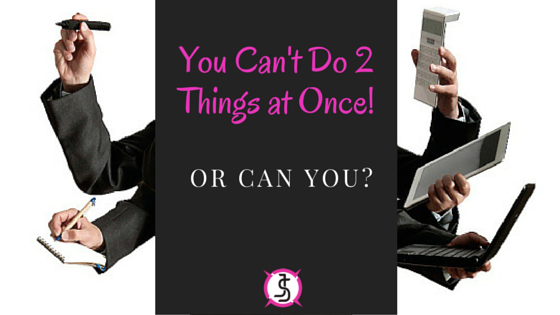
by author Jodi Stout
The results are in and it’s a landslide… multi-tasking is bad for productivity. In fact, you’re likely to do 40% less than if you remained focused on a single task and apparently the rapid context switching causes long term brain damage.
That frightening information comes from Devora Zack, author of Singletasking: Get More Done-One Thing at a Time.
Unfortunately, as a busy entrepreneur, you’re likely to wear many hats and be constantly on-call for any myriad of demands and multi-tasking is standard operating procedure.
Fortunately, there ARE ways to do more than one thing at a time. You can walk and chew gum, right? It’s not impossible for you to perform multiple tasks at a time, it’s more a matter of choosing the right ones to coordinate.
Here are some key tactics to minimize the inherent inefficiencies of multi-tasking and gain time, energy and mental clarity.
Capitalize on sensory processing. Your brain is constantly analyzing countless threads of incoming data and sending signals to your body to react accordingly. It’s already a master multi-tasker! One trick is to position yourself in an environment where stimuli are not competing with each other for the same headspace but rather enhancing or collaborating with other input sources.
For instance, listening to music while reading an email is not vying for as much of the same brain matter as listening to someone speak while listening to music. The competitive nature of two simultaneous audio sources causes one to diminish in priority. Sensory overload from too many similar sources causes a cognitive bottleneck, resulting in distraction and inability to focus.
It’s much easier to manage stimulus from different sources at the same time.
Compartmentalize tasks. Putting part of your brain on auto-pilot while you focus on a subject helps streamline mental resources for your task at hand. Have some podcasts to catch up on? An easy, effective multi-tasking choice is to listen to them while exercising, which has obvious added benefits.
Have an important email to write or graphic to create? Be sure to close other windows to cut off visually distracting stimuli. Conversation also competes with writing for your language faculties so keeping the door closed and the phone off will dramatically increase your ability to focus on a writing task.
Are you one of those that “mindlessly” doodles or paces while having an important phone conversation? This physical activity helps redirect primary brain activity to your priority task while keeping other “distractable” parts of your brain occupied. Studies in Applied Cognitive Psychology show that this type of multi-tasking activity actually boosts focus and increases retention.
Knowing how to effectively multi-task is key. Keeping these concepts in mind will help you develop personal strategies for productivity.
For more practical productivity and focus strategies, stay tuned for the next post!
Subscribe below to keep up to date.
Think you’re a good multi-tasker? Take this fascinating test. http://www.eurekalert.org/pub_releases/2009-02/w-dd022509.php
